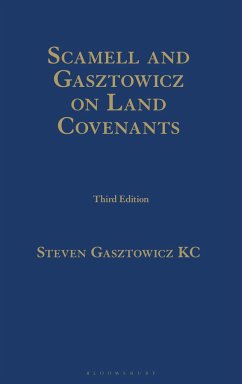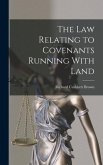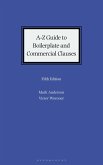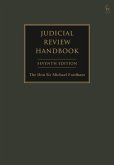Steven Gasztowicz Kc
Scamell and Gasztowicz on Land Covenants
Steven Gasztowicz Kc
Scamell and Gasztowicz on Land Covenants
- Gebundenes Buch
- Merkliste
- Auf die Merkliste
- Bewerten Bewerten
- Teilen
- Produkt teilen
- Produkterinnerung
- Produkterinnerung
This book covers a complex and broad area of law for property lawyers to contend with. Dealing with the impact of covenants on land affects most conveyancing transactions and is also of vital importance to landowners, developers and others. The volume of case law on this topic is extensive. This book includes coverage of positive covenants and planning covenants and is updated to include the major Supreme Court case on restrictive covenants, Alexander Devine Children's Cancer Trust v Housing Solutions Ltd [2020] 1 WLR 4783 and other major Court of Appeal decisions. It also deals with the…mehr
Andere Kunden interessierten sich auch für
![The Law Relating to Covenants Running With Land The Law Relating to Covenants Running With Land]() Richard Cuthbert BrownThe Law Relating to Covenants Running With Land31,99 €
Richard Cuthbert BrownThe Law Relating to Covenants Running With Land31,99 €![The Law of Covenants The Law of Covenants]() AnonymousThe Law of Covenants38,99 €
AnonymousThe Law of Covenants38,99 €![Human Rights Covenants at 50 Human Rights Covenants at 50]() Daniel MoeckliHuman Rights Covenants at 50133,99 €
Daniel MoeckliHuman Rights Covenants at 50133,99 €![Covenants and Third-Party Creditors Covenants and Third-Party Creditors]() Daniela MatriCovenants and Third-Party Creditors76,99 €
Daniela MatriCovenants and Third-Party Creditors76,99 €![Reform des europäischen Finanzaufsichtssystems als Vorbild für Ostasien Reform des europäischen Finanzaufsichtssystems als Vorbild für Ostasien]() Teuk Rok KangReform des europäischen Finanzaufsichtssystems als Vorbild für Ostasien129,95 €
Teuk Rok KangReform des europäischen Finanzaufsichtssystems als Vorbild für Ostasien129,95 €![A-Z Guide to Boilerplate and Commercial Clauses A-Z Guide to Boilerplate and Commercial Clauses]() Mark AndersonA-Z Guide to Boilerplate and Commercial Clauses253,99 €
Mark AndersonA-Z Guide to Boilerplate and Commercial Clauses253,99 €![Judicial Review Handbook Judicial Review Handbook]() The Hon Michael FordhamJudicial Review Handbook365,99 €
The Hon Michael FordhamJudicial Review Handbook365,99 €-
-
-
This book covers a complex and broad area of law for property lawyers to contend with. Dealing with the impact of covenants on land affects most conveyancing transactions and is also of vital importance to landowners, developers and others. The volume of case law on this topic is extensive. This book includes coverage of positive covenants and planning covenants and is updated to include the major Supreme Court case on restrictive covenants, Alexander Devine Children's Cancer Trust v Housing Solutions Ltd [2020] 1 WLR 4783 and other major Court of Appeal decisions. It also deals with the special position of local authorities in relation to land covenants, and has coverage on freeing land from restrictions. The book is divided into four main parts: Part I - Restrictive Covenants; Part II - Positive and Negative Covenants; Part III - Planning Obligations; Part IV - Reform. This title is included in Bloomsbury Professional's Property and Land Law online service.
Produktdetails
- Produktdetails
- Verlag: Bloomsbury Academic
- 3rd edition
- Seitenzahl: 1168
- Erscheinungstermin: 26. Dezember 2023
- Englisch
- Abmessung: 244mm x 170mm x 60mm
- Gewicht: 2032g
- ISBN-13: 9781526524447
- ISBN-10: 1526524449
- Artikelnr.: 66155512
- Herstellerkennzeichnung
- Libri GmbH
- Europaallee 1
- 36244 Bad Hersfeld
- gpsr@libri.de
- Verlag: Bloomsbury Academic
- 3rd edition
- Seitenzahl: 1168
- Erscheinungstermin: 26. Dezember 2023
- Englisch
- Abmessung: 244mm x 170mm x 60mm
- Gewicht: 2032g
- ISBN-13: 9781526524447
- ISBN-10: 1526524449
- Artikelnr.: 66155512
- Herstellerkennzeichnung
- Libri GmbH
- Europaallee 1
- 36244 Bad Hersfeld
- gpsr@libri.de
Steven Gasztowicz KC specialises in property matters, planning and public law, and commercial and regulatory work. He advises and represents local authorities, companies, and private individuals. He appears before all courts, ranging from the Supreme Court to the High Court and county court. Steven also sits as a deputy High Court Judge in both the Queen's Bench and Chancery Divisions, and as a Recorder, dealing with criminal, civil, and specialist chancery matters. He is also a qualified arbitrator. Steven has experience of a wide range of work, and provides authoritative and practical advice, as well as representation, particularly in the following areas: Property: rights of way, restrictive covenants, adverse possession, proprietary estoppel, trusts, highways, trespass, drainage law, nuisance claims, and commercial landlord and tenant Planning: planning and local plan inquiries, enforcement proceedings, statutory appeals, s106 obligations, ancillary rights, injunctions, and all other planning and planning-related work Public law: statutory powers, conduct matters, judicial review, and case stated, statutory, and other appeals Commercial and regulatory: contract, negligence and professional negligence, breach of statutory duty, misrepresentation, company, and regulatory matters His breadth of knowledge enables him to deal with matters crossing different fields, as well as those within individual practice areas. He works flexibly and quickly. Steven appears before the Supreme Court, the Court of Appeal, the High Court (both the Chancery and Queen's Bench Divisions, including the Administrative Court), county courts, and planning inspectors. He also appears before other tribunals, ranging from those dealing with property matters to disciplinary and other bodies.
Foreword
Preface
Table of Statutes
Table of Statutory Instruments
Table of Cases
Introduction: Covenants generally
Part I Restrictive covenants
1. Meaning of 'restrictive covenant' (including general consideration of
requirements for transmissibility)
2. The benefit of the restrictive covenant
3. 1: Original covenantees
4. 2: Covenant beneficiaries
5. 3: Subsequent owners and occupiers of land benefited by the restrictive
covenant as competent claimants: overview
6. Subsequent owners and occupiers of benefited land where there is
annexation
7. Competent claimants express assignment
8. Competent claimants: building schemes
9. The running of the burden of restrictive covenants
10. Restrictive covenants and public law
11. The construction of restrictive covenants
12. Restrictive covenants and competition law
13. Remedies for breach of a restrictive covenant
14. Freeing the title from unenforceable restrictive covenants
15. Extinguishment, discharge and modification of restrictive covenants
16. The modification and discharge of restrictive covenants and agreements
by the Upper Tribunal (Lands Chamber) pursuant to section 84(1) of the Law
of Property Act 1925
17. The scope of the Upper Tribunal's powers under section 84(1) of the Law
of Property Act 1925
18. The four alternative grounds giving rise to the Upper Tribunal's powers
19. The grounds giving rise to the Upper Tribunal's powers: paragraph (a)
20. Section 84(1) of the Law of Property Act 1925: paragraph (aa)
21. Section 84(1) of the Law of Property Act 1925: paragraph (b)
22. Section 84(1) of the Law of Property Act 1925: paragraph (c)
23. The power of the Upper Tribunal to award compensation
24. Procedure on an application to the Upper Tribunal under section 84(1)
of the Law of Property Act 1925
Part II Positive covenants and negative covenants which are not restrictive
covenants
25. Meaning of 'positive covenants' and of 'negative covenants which are
not restrictive covenants' and frequency of use
26. Persons able to claim the benefit of positive covenants: (I) Original
covenantees
27. Persons able to claim the benefit of positive covenants: (II)
Subsequent owners and occupiers of the benefited land
28. The burden of positive covenants
29. Methods of securing the indirect running of the burden of a positive
covenant
30. Remedies for breach of positive covenants
31. Covenants and commonhold
Part III Planning obligations relating to land
32. Planning obligations
Part IV Reform
33. Reform of the law relating to restrictive covenants: Law Commission
proposals
Preface
Table of Statutes
Table of Statutory Instruments
Table of Cases
Introduction: Covenants generally
Part I Restrictive covenants
1. Meaning of 'restrictive covenant' (including general consideration of
requirements for transmissibility)
2. The benefit of the restrictive covenant
3. 1: Original covenantees
4. 2: Covenant beneficiaries
5. 3: Subsequent owners and occupiers of land benefited by the restrictive
covenant as competent claimants: overview
6. Subsequent owners and occupiers of benefited land where there is
annexation
7. Competent claimants express assignment
8. Competent claimants: building schemes
9. The running of the burden of restrictive covenants
10. Restrictive covenants and public law
11. The construction of restrictive covenants
12. Restrictive covenants and competition law
13. Remedies for breach of a restrictive covenant
14. Freeing the title from unenforceable restrictive covenants
15. Extinguishment, discharge and modification of restrictive covenants
16. The modification and discharge of restrictive covenants and agreements
by the Upper Tribunal (Lands Chamber) pursuant to section 84(1) of the Law
of Property Act 1925
17. The scope of the Upper Tribunal's powers under section 84(1) of the Law
of Property Act 1925
18. The four alternative grounds giving rise to the Upper Tribunal's powers
19. The grounds giving rise to the Upper Tribunal's powers: paragraph (a)
20. Section 84(1) of the Law of Property Act 1925: paragraph (aa)
21. Section 84(1) of the Law of Property Act 1925: paragraph (b)
22. Section 84(1) of the Law of Property Act 1925: paragraph (c)
23. The power of the Upper Tribunal to award compensation
24. Procedure on an application to the Upper Tribunal under section 84(1)
of the Law of Property Act 1925
Part II Positive covenants and negative covenants which are not restrictive
covenants
25. Meaning of 'positive covenants' and of 'negative covenants which are
not restrictive covenants' and frequency of use
26. Persons able to claim the benefit of positive covenants: (I) Original
covenantees
27. Persons able to claim the benefit of positive covenants: (II)
Subsequent owners and occupiers of the benefited land
28. The burden of positive covenants
29. Methods of securing the indirect running of the burden of a positive
covenant
30. Remedies for breach of positive covenants
31. Covenants and commonhold
Part III Planning obligations relating to land
32. Planning obligations
Part IV Reform
33. Reform of the law relating to restrictive covenants: Law Commission
proposals
Foreword
Preface
Table of Statutes
Table of Statutory Instruments
Table of Cases
Introduction: Covenants generally
Part I Restrictive covenants
1. Meaning of 'restrictive covenant' (including general consideration of
requirements for transmissibility)
2. The benefit of the restrictive covenant
3. 1: Original covenantees
4. 2: Covenant beneficiaries
5. 3: Subsequent owners and occupiers of land benefited by the restrictive
covenant as competent claimants: overview
6. Subsequent owners and occupiers of benefited land where there is
annexation
7. Competent claimants express assignment
8. Competent claimants: building schemes
9. The running of the burden of restrictive covenants
10. Restrictive covenants and public law
11. The construction of restrictive covenants
12. Restrictive covenants and competition law
13. Remedies for breach of a restrictive covenant
14. Freeing the title from unenforceable restrictive covenants
15. Extinguishment, discharge and modification of restrictive covenants
16. The modification and discharge of restrictive covenants and agreements
by the Upper Tribunal (Lands Chamber) pursuant to section 84(1) of the Law
of Property Act 1925
17. The scope of the Upper Tribunal's powers under section 84(1) of the Law
of Property Act 1925
18. The four alternative grounds giving rise to the Upper Tribunal's powers
19. The grounds giving rise to the Upper Tribunal's powers: paragraph (a)
20. Section 84(1) of the Law of Property Act 1925: paragraph (aa)
21. Section 84(1) of the Law of Property Act 1925: paragraph (b)
22. Section 84(1) of the Law of Property Act 1925: paragraph (c)
23. The power of the Upper Tribunal to award compensation
24. Procedure on an application to the Upper Tribunal under section 84(1)
of the Law of Property Act 1925
Part II Positive covenants and negative covenants which are not restrictive
covenants
25. Meaning of 'positive covenants' and of 'negative covenants which are
not restrictive covenants' and frequency of use
26. Persons able to claim the benefit of positive covenants: (I) Original
covenantees
27. Persons able to claim the benefit of positive covenants: (II)
Subsequent owners and occupiers of the benefited land
28. The burden of positive covenants
29. Methods of securing the indirect running of the burden of a positive
covenant
30. Remedies for breach of positive covenants
31. Covenants and commonhold
Part III Planning obligations relating to land
32. Planning obligations
Part IV Reform
33. Reform of the law relating to restrictive covenants: Law Commission
proposals
Preface
Table of Statutes
Table of Statutory Instruments
Table of Cases
Introduction: Covenants generally
Part I Restrictive covenants
1. Meaning of 'restrictive covenant' (including general consideration of
requirements for transmissibility)
2. The benefit of the restrictive covenant
3. 1: Original covenantees
4. 2: Covenant beneficiaries
5. 3: Subsequent owners and occupiers of land benefited by the restrictive
covenant as competent claimants: overview
6. Subsequent owners and occupiers of benefited land where there is
annexation
7. Competent claimants express assignment
8. Competent claimants: building schemes
9. The running of the burden of restrictive covenants
10. Restrictive covenants and public law
11. The construction of restrictive covenants
12. Restrictive covenants and competition law
13. Remedies for breach of a restrictive covenant
14. Freeing the title from unenforceable restrictive covenants
15. Extinguishment, discharge and modification of restrictive covenants
16. The modification and discharge of restrictive covenants and agreements
by the Upper Tribunal (Lands Chamber) pursuant to section 84(1) of the Law
of Property Act 1925
17. The scope of the Upper Tribunal's powers under section 84(1) of the Law
of Property Act 1925
18. The four alternative grounds giving rise to the Upper Tribunal's powers
19. The grounds giving rise to the Upper Tribunal's powers: paragraph (a)
20. Section 84(1) of the Law of Property Act 1925: paragraph (aa)
21. Section 84(1) of the Law of Property Act 1925: paragraph (b)
22. Section 84(1) of the Law of Property Act 1925: paragraph (c)
23. The power of the Upper Tribunal to award compensation
24. Procedure on an application to the Upper Tribunal under section 84(1)
of the Law of Property Act 1925
Part II Positive covenants and negative covenants which are not restrictive
covenants
25. Meaning of 'positive covenants' and of 'negative covenants which are
not restrictive covenants' and frequency of use
26. Persons able to claim the benefit of positive covenants: (I) Original
covenantees
27. Persons able to claim the benefit of positive covenants: (II)
Subsequent owners and occupiers of the benefited land
28. The burden of positive covenants
29. Methods of securing the indirect running of the burden of a positive
covenant
30. Remedies for breach of positive covenants
31. Covenants and commonhold
Part III Planning obligations relating to land
32. Planning obligations
Part IV Reform
33. Reform of the law relating to restrictive covenants: Law Commission
proposals








